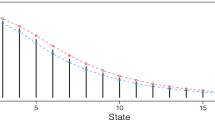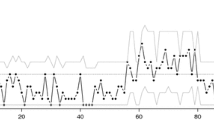Abstract
This article redefines the self-exciting threshold integer-valued autoregressive (SETINAR(2,1)) processes under a weaker condition that the second moment is finite, and studies the quasi-likelihood inference for the new model. The ergodicity of the new processes is discussed. Quasi-likelihood estimators for the model parameters and the asymptotic properties are obtained. Confidence regions of the parameters based on the quasi-likelihood method are given. A simulation study is conducted for the evaluation of the proposed approach and an application to a real data example is provided.






Similar content being viewed by others
References
Al-Osh MA, Alzaid AA (1987) First-order integer-valued autoregressive (INAR(1)) process. J Time Ser Anal 8:261–275
Al-Osh MA, Alzaid AA (1991) Binomial autoregressive moving average models. Commun Stat Stoch Models 7:261–282
Al-Osh MA, Alzaid AA (1992) First order autoregressive time series with negative binomial and geometric marginals. Commun Stat Theory Methods 21:2483–2492
Alzaid AA, Al-Osh MA (1988) First-order integer-valued autoregressive (INAR(1)) process: distributional and regression properties. Stat Neerlandica 42(1):53–61
Aue A, Horváth L (2011) Quasi-likelihood estimation in stationary and nonstationary autoregressive models with random coefficients. Stat Sin 21:973–999
Azrak R, Mélard G (1998) The exact quasi-likelihood of time-dependent ARMA models. J Stat Plan Inference 68:31–45
Azrak R, Mélard G (2006) Asymptotic properties of quasi-maximum likelihood estimators for ARMA models with time-dependent coefficients. Stat Inference Stoch Process 9:279–330
Billingsley P (1961) Statistical inference for Markov processes. The University of Chicago Press, Chicago
Christou V, Fokianos K (2014) Quasi-likelihood inference for negative binomial time series models. J Time Ser Anal 35:55–78
Du JG, Li Y (1991) The integer-valued autoregressive (INAR(\(p\))) model. J Time Ser Anal 12:129–142
Hall P, Heyde CC (1980) Martingale limit theory and its applation. Academic Press, New York
Jung SH (1996) Quasi-likelihood for median regression models. J Am Stat Assoc 91:251–257
Kim HY, Park Y (2008) A non-stationary integer-valued autoregressive model. Stat Pap 49:485–502
Kreiss J, Lahiri SN (2012) Bootstrap methods for time series. In: Rao TS, Rao SS, Rao CR (eds) Handbook of statistics, vol 30. Elsevier, Amsterdam, pp 1–24
Li D, Tong H (2016) Nested sub-sample search algorithm for estimation of threshold models. Stat Sin 26:1543–1554
Li C, Wang D, Zhang H (2015) First-order mixed integer-valued autoregressive processes with zero-inflated generalized power series innovations. J Korean Stat Soc 44:232–246
Ling S (2007) Self-weighted and local quasi-maximum likelihood estimators for ARMA-GARCH/IGARCH models. J Econom 140:849–873
Lu JC, Chen D, Zhou W (2006) Quasi-likelihood estimation for GLM with random scales. J Stat Plan Inference 136:401–429
McCullagh P, Nelder JA (1989) Generalized linear models, 2nd edn. Springer, New York
Monteiro M, Scotto MG, Pereira I (2012) Integer-valued self-exciting threshold autoregressive processes. Commun Stat Theory Method 41:2717–2737
Möller TA, Weiß CH (2015) Stochastic models, statistics and their applications. In: Steland (ed) Threshold models for integer-valued time series with infinte and finte range Springer Proceedings in Mathematics and Statistics. Springer, Berlin, pp 327–334
Niaparast M, Schwabe R (2013) Optimal design for quasi-likelihood estimation in Poisson regression with random coefficients. J Stat Plan Inference 143:296–306
Ristić MM, Bakouch HS, Nastić AS (2009) A new geometric first-order integer-valued autoregressive (NGINAR(1)) process. J Stat Plan Inference 139:2218–2226
Ruiz E (1994) Quasi-maximum likelihood estimation of stochastic volatility models. J Econom 1994(63):289–306
Severini TA, Staniswalis JG (1994) Quasilikelihood estimation in semiparametric models. J Am Stat Assoc 89:501–511
Scotto MG, Weiß CH, Gouveia S (2015) Thinning-based models in the analysis of integer-valued time series: a review. Stat Model 15:590–618
Steutel F, van Harn K (1979) Discrete analogues of self-decomposability and stability. Ann Probab 7:893–899
Sutardhar BC, Rao RP (2001) On marginal quasi-likelihood inference in generalized linear mixed models. J Multivar Anal 76:1–34
Tong H (1978) On a threshold model. In: Chen CH (ed) Pattern recognition and signal processing. Sijthoff and Noordhoff, Amsterdam, pp 575–586
Tong H, Lim KS (1980) Threshold autoregressive, limit cycles and cyclical data. J R Stat Soc B 42:245–292
Tweedie RL (1975) Sufficient conditions for regularity, recurrence and ergocidicity of Markov process. Stoch Process Appl 3:385–403
Wang C, Liu H, Yao J, Davis RA, Li WK (2014) Self-excited threshold Poisson autoregression. J Am Stat Assoc 2014(109):777–787
Wedderburn RWM (1974) Quasi-likelihood functions, generalized linear models, and the Gauss-Newton method. Biometrika 1974(61):439–447
Weiß CH (2008) Thinning operations for modeling time series of counts—a survey. Adv Stat Anal 92:319–343
Yang K, Wang D, Jia B, Li H (2017) An integer-valued threshold autoregressive process based on negative binomial thinning. Stat Pap. doi:10.1007/s00362-016-0808-1
Zhang H, Wang D, Zhu F (2010) Inference for INAR(\(p\)) processes with signed generalized powerseries thinning operator. J Stat Plan Inference 140:667–683
Zheng H, Basawa IV (2008) First-order observation-driven integer-valued autoregressive processes. Stat Prob Lett 78:1–9
Zheng H, Basawa IV, Datta S (2006a) Inference for \(p\)th order random coefficient integer-valued autoregressive processes. J Time Ser Anal 27:411–440
Zheng H, Basawa IV, Datta S (2006b) First-order random coefficient integer-valued autoregressive processes. J Stat Plan Inference 137:212–229
Acknowledgements
This work is supported by National Natural Science Foundation of China (Nos. 11271155, 11371168, J1310022, 11571138, 11501241, 11571051, 11301137), National Social Science Foundation of China (16BTJ020), Science and Technology Research Program of Education Department in Jilin Province for the 12th Five-Year Plan (440020031139) and Jilin Province Natural Science Foundation (20150520053JH).
Author information
Authors and Affiliations
Corresponding author
Appendix
Appendix
Proof of Proposition 2.1
According to Theorem 3.1 of Tweedie (1975)(or Proposition 2.2 of Zheng and Basawa 2008), the sufficient condition of \(\{X_t\}\) to be ergodic is that there exists a set K and a non-negative measurable function g on state space \(\mathbb {N}_0\) such that
and for some fixed B,
where \(P(x,A)=P(X_1\in A|X_0=x).\) Let \(g(x)=x,\) we have
where \(\alpha _{\max }=\max \{\alpha _1,\alpha _2\}<1.\) let \(N=[\frac{1+\lambda }{1-\alpha _{\max }}]+1\), where [x] denotes the integer part of x. Then for \(x_0\ge N,\) we have
and for \(0\le x_0\le N-1,\)
Let \(K=\{0,1, \ldots ,N-1\},\) then (5.1) and (5.2) both hold which completes the proof. \(\square \)
Proof of Theorem 2.1
First, we suppose \(\varvec{\theta }\) is known. Let \(\mathcal {F}_t=\sigma (X_0,X_1, \ldots ,X_t)\) be the \(\sigma \)-field generated by \(\{X_0,X_1, \ldots ,X_t\}\). For the following estimation equations:
we have
and
Thus, \(\{S_t^{(1)}(\varvec{\theta },\varvec{\beta }),\mathcal {F}_{t},~t\ge 0\}\) is a martingale. By (C1) and Theorem 1.1 in Billingsley (1961),
Hence, by Corollary 3.2 in Hall and Heyde (1980) and the central limit theorem of martingale, we have,
Similarly,
and
We can verify that \(\{S_t^{(i)}(\varvec{\theta },\varvec{\beta }),\mathcal {F}_{t},~t\ge 0\}\) \((i=2,3)\) are also martingales. Similar to the previous discussion, we have
By Cramer-Wold device, for any \(\varvec{c}^\textsf {T}=(c_1,c_2,c_3) \in \mathbb {R}^3\) and \((c_1,c_2,c_3)\ne (0,0,0)\), we have
implying
Now, we replace \(V_{\varvec{\theta }}(X_t|X_{t-1})\) with \(V_{\hat{\varvec{\theta }}}(X_t|X_{t-1})\), where \(\hat{\varvec{\theta }}\) is a consistent estimator of \({\varvec{\theta }}\). Then we want
To prove (5.3), we need to check that
Let \(R_n(\varvec{\theta })=(1/\sqrt{n})S_n^{(1)}(\varvec{\theta },\varvec{\beta })\). Then for any \(\varepsilon >0\) and \(\delta >0\), we have
where \(\varvec{\theta }_1=(\theta _1^{1},\theta _2^{1},\sigma _1^{2})^\textsf {T}, D:=\{|\theta _1^{1}-\theta _1|<\delta ,|\theta _2^{1}-\theta _2|<\delta ,|\sigma _1^{2}-\sigma _z^2|<\delta \}.\) If \(\hat{\varvec{\theta }}\) is a consistent estimator of \({\varvec{\theta }}\), then we just need to prove that
By Markov inequality,
where \(m_i~(i=1,2, \ldots ,6)\) denote some finite moments of process \(\{X_t\}\), C is a positive constant. Similar argument can be used for \(1/\sqrt{n}S_n^{(i)}(\varvec{\theta },\varvec{\beta })(i=2,3)\). For any fixed \(\varepsilon >0\), letting \(\delta \rightarrow 0\), we get our assertion which in turn establishes (5.3).
Finally, by the ergodic theorem, we have
After some algebra, we have,
Therefore,
The proof is complete. \(\square \)
Proof of Theorem 2.2
The proof follows by the ergodic theorem. \(\square \)
Proof of Theorem 2.3
The proof follows from Theorem 2.1. \(\square \)
Rights and permissions
About this article
Cite this article
Li, H., Yang, K. & Wang, D. Quasi-likelihood inference for self-exciting threshold integer-valued autoregressive processes. Comput Stat 32, 1597–1620 (2017). https://doi.org/10.1007/s00180-017-0748-9
Received:
Accepted:
Published:
Issue Date:
DOI: https://doi.org/10.1007/s00180-017-0748-9




